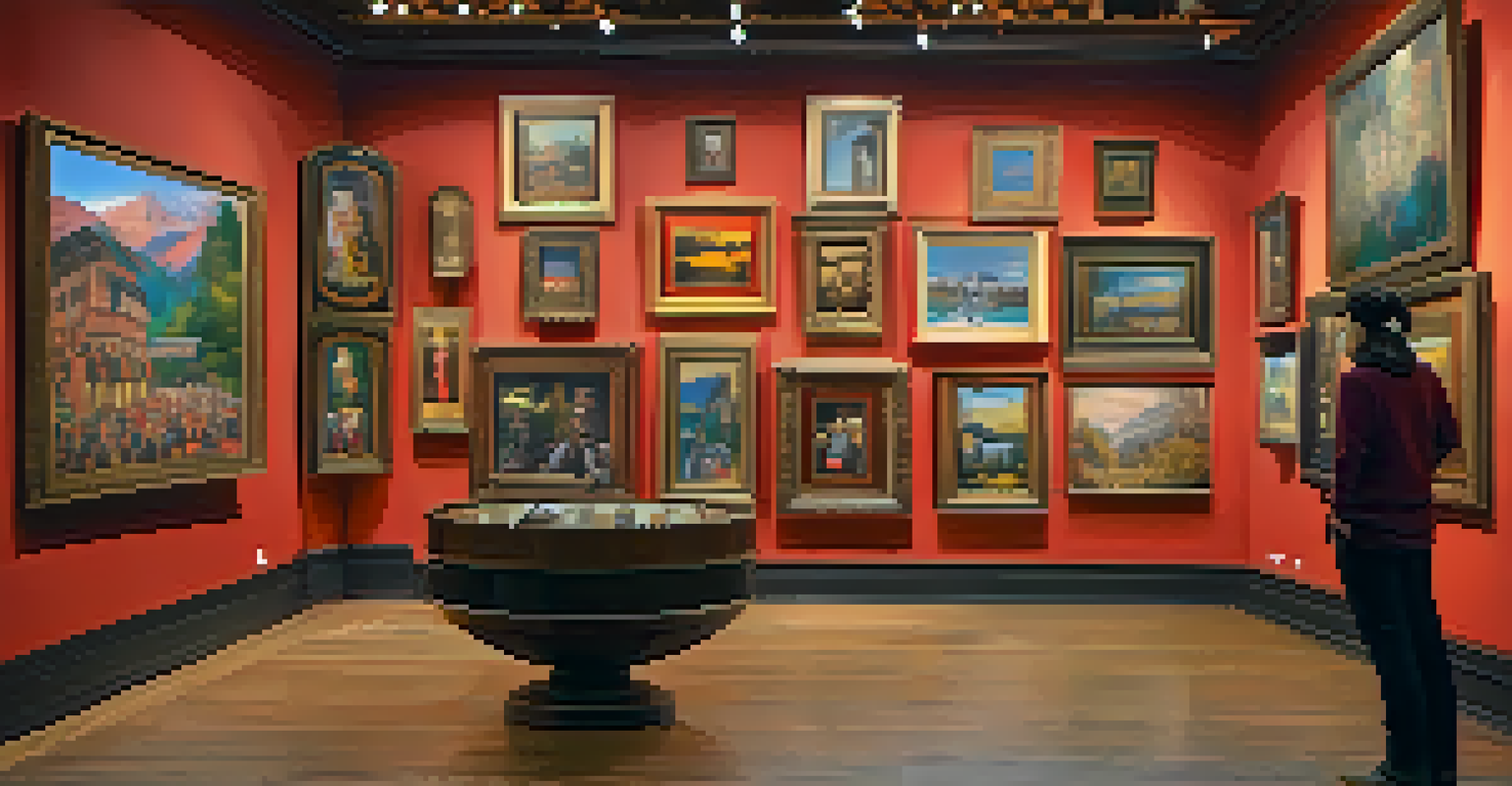The Impact of Paintings on Character Development in Film

The Role of Visual Art in Film Narrative
Paintings in film often serve as a powerful storytelling device, enriching the narrative. They can symbolize a character's emotions, aspirations, or inner turmoil, acting as visual metaphors that deepen viewer understanding. For instance, a character might gaze at a vibrant landscape painting, reflecting their longing for freedom and adventure.
Art is the most beautiful of all lies.
Moreover, the choice of artwork can be indicative of a character's personality or growth. A stark, dark painting might represent a troubled past, while a bright, colorful piece could signify a newfound hope. This contrast not only adds layers to the character but also invites the audience to interpret their journey.
Ultimately, visual art in film acts as a bridge between the audience's perception and the character's inner world, enhancing engagement and emotional connection.
Symbolism and Themes in Artistic Representations
Artistic representations, such as paintings, are rich in symbolism that can illuminate key themes in a film. A well-placed painting can carry historical or cultural significance that resonates with a character's journey. For example, a character might interact with a painting of their homeland, evoking nostalgia and a sense of belonging.

The symbolism inherent in these artworks often transcends the immediate visual experience, inviting viewers to explore deeper themes like loss, identity, or redemption. This layered approach allows filmmakers to convey complex ideas without lengthy exposition, keeping the narrative tight and engaging.
Art as a Storytelling Device
Paintings in film serve as powerful visual metaphors that enhance character emotions and deepen viewer understanding.
By weaving symbolism into the visual fabric of the film, directors can create a more immersive experience, allowing audiences to explore themes that resonate on a personal level.
Character Transformation Through Artistic Engagement
Characters often undergo transformation through their interactions with paintings, which can catalyze their development. A pivotal scene might show a character confronting a painting that embodies their fears, prompting them to face their struggles head-on. This confrontation can lead to profound character growth.
Every artist dips his brush in his own soul, and paints his own nature into his pictures.
For instance, consider a film where a character starts as disillusioned and detached but finds inspiration in a piece of art that reflects their aspirations. This engagement can spark a journey of self-discovery, allowing for a compelling narrative arc that captures the audience's attention.
Thus, paintings can serve not just as passive backdrops but as active participants in a character's evolution, driving the narrative forward.
Cultural Context and Character Depth
The cultural context of paintings featured in films adds significant depth to character development. An artwork rooted in a specific culture can provide insight into a character's background, values, and motivations. For example, a character from a culturally rich heritage might find solace in traditional artwork, reflecting their connection to their roots.
Additionally, showcasing diverse artistic styles can highlight a character's personal growth or conflict, especially if they struggle between traditional values and contemporary influences. This dynamic can lead to rich storytelling that resonates with viewers from various backgrounds.
Symbolism Reveals Character Depth
Artworks can illuminate key themes and character backgrounds, enriching the narrative and inviting personal interpretation.
In this way, the integration of culturally significant paintings can enhance character complexity and foster a deeper connection with the audience.
The Emotional Resonance of Art in Film
Art has a unique ability to evoke emotions, and its presence in film can amplify a character's emotional journey. A poignant painting can serve as a visual cue for the audience, signaling a moment of reflection, joy, or sorrow for the character. This emotional resonance helps viewers feel more connected to the narrative.
For example, a character might find themselves in front of a melancholic painting after a significant loss, using it as a vehicle for processing their grief. This visual representation allows the audience to empathize with the character on a deeper level, making their struggles feel more relatable.
Thus, the emotional power of art can enhance storytelling, creating memorable moments that linger long after the credits roll.
Artistic Techniques: Lighting and Color in Character Moments
The way paintings are lit or colored in a film can dramatically impact how a character's emotions are perceived. For instance, warm lighting on a vibrant painting can evoke feelings of happiness and hope, while dim lighting on a darker piece might suggest despair or introspection. This visual manipulation helps set the emotional tone for the scene.
Using color theory, filmmakers can influence audience reactions and character interpretation. A character surrounded by bright, lively colors might appear more optimistic, while muted tones could indicate struggle or conflict. This technique allows for a more nuanced portrayal of character development.
Transformative Power of Art
Interactions with paintings can catalyze character development, driving their journey of self-discovery and emotional growth.
In essence, the interplay of artistic techniques with character moments enhances the storytelling, making it visually engaging and emotionally resonant.
Case Studies: Iconic Films Utilizing Paintings
Several iconic films have masterfully incorporated paintings to enhance character development. Take 'Girl with a Pearl Earring,' for example, where the titular painting becomes a focal point for the protagonist's journey from obscurity to recognition. The artwork embodies her transformation and desire for artistic validation.
Another example is 'The Great Gatsby,' where various artworks symbolize the characters' aspirations and failures, particularly through the green light motif. The paintings and their interpretations play a crucial role in portraying the characters’ emotional landscapes.

These case studies highlight how effectively paintings can be woven into narratives, elevating character arcs and enriching the overall film experience.